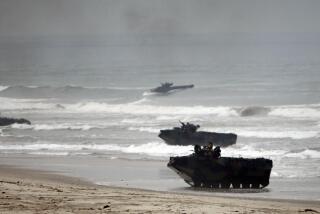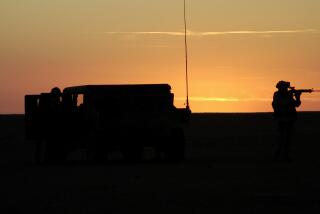Wounded Marines Now Look to Their Future
- Share via
Lance Cpl. Mary Klice figures the leg injury she suffered in Iraq has pretty much torpedoed her Marine Corps career and probably her civilian construction job too.
As she undergoes rehabilitation at Camp Pendleton and awaits release from active duty, Klice now contemplates the frightening question that U.S. service men and women injured and wounded in previous wars have faced: “What am I going to do when I take off the uniform for the last time?”
Klice pondered her own future Wednesday, a day after returning to the United States from a military hospital in Germany, now that she probably won’t be able to drive the 22 1/2-ton Marine Corps supply truck -- or the bulldozer and front loader she piloted on construction projects.
“My right leg was torn up pretty good,” said the 28-year-old native of Friendship, N.Y., one of 11 Marines injured in the war who spoke at the base of their combat and sacrifice. “All of my cartilage was ripped up. I’m going to have a tough time getting in and out of a truck.”
But she was grateful to be back in the United States and was thinking positively of her options. “If I can’t work, I’ll go back to college and get my degree [in advertising],” said Klice, who has spent more than eight years on active and reserve duty. “I’ve got one year of school left.”
Survival was the only thing on Klice’s mind when she was injured March 29 near Baghdad after delivering water to front-line troops.
Assigned to the 6th Motors Battalion, a reserve unit activated in January, Klice was pulling a double trailer in a sandstorm that cut visibility to near zero. As she rounded a turn, she slammed into the back of another truck that had stopped.
She was pinned in the wreckage.
Other Marines pulled her out, but it was nine hours before she was transported to a field hospital. Eventually, she was transferred to the medical ship Comfort, then to a hospital in Germany.
“Even before the accident I was scared,” she said of the sandstorm. “All of us were. But we kept moving forward because the people at the front needed supplies to continue fighting.”
Bryan Driver, spokesman for the Marines’ Personal and Readiness Division in Virginia, said Klice probably will remain on active status until while she recuperates and completes rehabilitation.
Before she is “separated” from active duty, a medical retirement board will probably evaluate the extent of her injury and the amount of any disability pension. The entire process may take months, he said.
Before Klice, who is single, returns to civilian life she also will undergo a three-day transition program at Camp Pendleton, where counselors such as retired Marine Sgt. Maj. Dan Clouse will tell her about the medical and education benefits she has earned.
“We talk to them about job searching and benefits. But the most important thing we tell them is to file a claim” with the Department of Veterans Affairs, Clouse said.
“We pound that into them and bring in a VA specialist who talks to them for two hours about how to file a claim.”
If the VA finds that Klice’s injury substantially limits her abilities, she may be placed in a vocational rehabilitation program and assessed to find the career best suited to her, Clouse said. VA officials may help her find a job, or even a university to finish her last year of school and pay her tuition.
Clouse, a Vietnam veteran, said the benefits for injured or wounded service members have greatly improved since the Vietnam War ended in 1975, as has the military’s willingness to highlight injured soldiers.
None of the Marines who spoke with reporters Wednesday would say if they were ordered to make themselves available, but media relations officers were clearly pleased at the number of photographers and reporters who came to the base.
Professor James R. Reckner, director of the Vietnam Center at Texas Tech University, said wounded Vietnam veterans usually returned to the U.S. in secrecy and away from public view, as if they were a symbol of shame.
“People really didn’t want to see the WIAs [wounded in action] from Vietnam. The war went on for so many years, and the scale of wounded [303,704] was so big. There was no publicity for their return, because it would’ve been ill received for the Johnson and Nixon administrations,” said Reckner, a Vietnam veteran.
“Thankfully,” he said, the number of wounded and killed in “this conflict are smaller and easier for the public to accept.”
More to Read
Sign up for Essential California
The most important California stories and recommendations in your inbox every morning.
You may occasionally receive promotional content from the Los Angeles Times.










